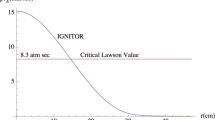Abstract
The effect of plasma profiles for ignition condition in a stationary D–T plasma is investigated using the energy conservation equations for ions and electrons, assuming that steady state fusion power is produced with no external power. The alpha power heating is sufficiently large to sustain the plasma and to balance the combined Bremsstarhlung and thermal conduction losses. The space dependent Lawson criteria is derived and critical condition is identified. As a result of this analysis we have shown that the optimum temperature might be \(\bar{T} \approx 26\,{\text{keV}}\) and that the peaked profiles with \(n\sim\left( {1 - \frac{{r^{2} }}{{a^{2} }}} \right)^{{v_{n} }}\), ν n = 1, and \(T\sim\left( {1 - \frac{{r^{2} }}{{a^{2} }}} \right)^{{v_{T} }} ,\,v_{T} = 2\) are good to minimizing \(\bar{n}\uptau_{E}\) for ignition. The results for these profiles show the critical value of \((\bar{n}\uptau_{E} )_{min} = 0.08 \times 10^{20 } \,{\text{m}}^{ - 3} \,{\text{s}}\) showing the reduction by 1/3 from the reference value limit ν n = ν T = 0. For a 26 keV plasma with an energy confinement time of 1 s, a pressure of about 6.24 atm is required for the plasma to be ignited; that is, it is sustained purely by the self-heating of the fusion alpha particles.







Similar content being viewed by others
References
D.M. Meade, C.E. Kessel, M.A. Ulricksonet et al., in Advanced tokamak regimes in the fusion ignition research experiment (FIRE). Proceedings of the 30th European Physical Society Conference on Controlled Fusion and Plasma Physics (7–11 July 2003, St. Petersburg, Russia). http://eps2003.ioffe.ru/
T.J. Dolan, Fusion reaserch, corrected edn. (Pergamon Press, Oxford, 2000)
M. Jakobs, N. Lopes Cardozo, R. Jaspers, Fusion burn equilibria sensitive to the ratiobetween energy and helium transport. Nucl. Fusion 54, 122005–122009 (2014)
B. Coppi, A. Airoldi, F. Bombarda, G. Cenacchi, P. Detragiache, L.E. Sugiyama. Optimal regimes for ignition and the igniter experiment, Nucl. Fusion, 41 (2001)
M. Greenwald, D. Gwinn, S. Milora et al., Phys. Rev. Lett. 53, 352 (1984)
B. Coppi, Comments Plasma Phys. Controll. Fusion 5, 261 (1979)
B. Coppi, E. Mazzucato, Phys. Lett. 71A, 337 (1979)
R.J. Goldston, Plasma Phys. Controll. Fusion 26, 87 (1984)
P.H. Rebut, M. Brusati, Plasma Phys. Controll. Fusion 28, 113 (1986)
H.P. Furth, A.H. Glasser, W. Park, P.H. Rutherford, H. Selberg, R.B. White, in Controlled fusion and plasma physics (Proceedings of 12th European Conference, Budapest, 1985), Vol. 3, European Physical Society (1985) 358
B.B. Kadomtsev, Philos. Trans. R. Soc. London A322, 125 (1987); also “Tokamak Plasma Self-Organization”, talk at IAEA INTOR Workshop (Kyoto, Japan, 1986)
J. Kesner, R.W. Conn, Space-dependent effects on the lawson and ignition conditions and thermal equilibria in tokamaks. Nucl. Fusion 16(3), 397 (1976)
W.M. Stacey, Fusion plasma physics (Wiley-VCH, Hoboken, 2005)
J. Friedberg, Plasma physics and fusion energy (Cambridge University Press, Cambridge, 2007)
H.S. Bosch, G.M. Hale, Improved formulas for fusion cross-section and thermal reactivities. Nucl. Fusion 32, 611–663 (1992)
T.A. Hltemes, G.A. Moses, J.F. Santerius, Analysis of an improved fusion reaction rate model for use in fusion plasma simulation (Fusion Technology Institute, University of Wisconsin, Madison, 2005)
Author information
Authors and Affiliations
Corresponding author
Rights and permissions
About this article
Cite this article
Khosrowpour, B., Nassiri-Mofakham, N. The Effect of Plasma Profiles on the Critical Value of \(n\uptau_{E}\) for Ignition. J Fusion Energ 35, 513–518 (2016). https://doi.org/10.1007/s10894-016-0084-z
Published:
Issue Date:
DOI: https://doi.org/10.1007/s10894-016-0084-z




